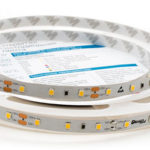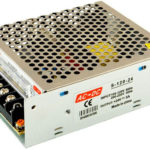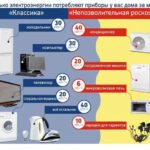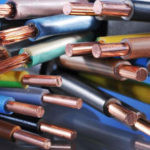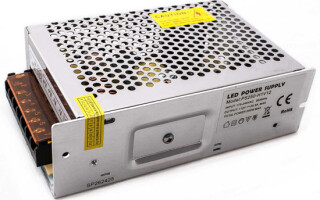Decorative or basic lighting with LED strips has recently become widespread. Since such tapes are powered by a constant voltage of 12V (less often 24V), then for the durable and proper operation of such lighting, it is important to choose the right step-down transformer or, as it is also called, a power supply. In this article, we will consider the main criteria for choosing such a device.
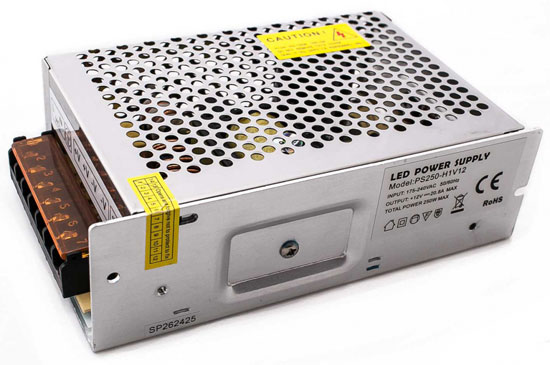
Content
The main technical parameters of the LED strip power supply
LED strip power supply – a step-down transformer, which converts an alternating voltage of 220 volts to a constant voltage of 12 or 24 volts. Power supplies for such lighting devices are produced impulse execution, which are based on the transformation of the input voltage into high-frequency pulses, so that the DC voltage at the output has a high-quality rectification. Such devices have a fairly high efficiency, compact size and good technical characteristics.
PSU output voltage
Due to the design features, LED strip manufacturers produce devices with a supply voltage of 12 or 24 volts DC. Sometimes, for very powerful tapes, a voltage of 36 volts is used, but this is rather an exception. An important rule when choosing a transformer is that the voltage at the output of it must match the voltage of the LED strip.
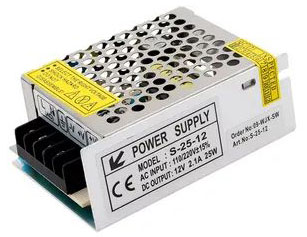
How to calculate the power supply for the LED strip
The most important characteristic, after voltage, for selecting a transformer for a particular light-emitting tape is power. This parameter of the power supply must be at least 20 percent higher than the power of the LED strip. Usually, the power of electrical appliances is indicated on its body. LED strips and transformers are no exception. But it happens that this characteristic is not indicated on the LED strip and, in this regard, it may be difficult to calculate the required power supply.
It is important to understand that the power of an LED strip directly depends on the type of LEDs, the density of their mounting on the strip and its length.
Different types of matrices have different power values, which can vary significantly. For example, popular LEDs have the following powers:
| Light-emitting diode | 3528 | 5630 | 5050 | 2835 | 5730 |
|---|---|---|---|---|---|
| LED power, W | 0,11 | 0,5 | 0,3 | 0,2 | 0,5 |
Note! The numbers in the brand of the LED indicate its size in millimeters, for example, 3528 - 35 mm by 28 mm.
Knowing (or counting) the number of diodes per 1 meter of the tape, you can calculate the power for its entire length. For convenience, tables with the power of tapes of each type have long been calculated and are freely available, focusing on these tables, you can correctly and easily choose a power supply for an LED strip.
| Tape type | Density of LEDs per 1 meter | Power 1 meter tape | Power 5 meters tape |
|---|---|---|---|
| SMD3014 | 60 pcs | 6.0W | 30 W |
| 120 pcs | 12.0W | 60 W | |
| 240 pcs | 24.0 W | 120 W | |
| SMD3528 | 30 pcs. | 2.4 W | 12 W |
| 60 pcs | 4.8W | 24 W | |
| 120 pcs | 9.6W | 48 W | |
| SMD5050 | 30 pcs. | 7.2 W | 36 W |
| 60 pcs | 14.4W | 72 W | |
| SMD5630 | 30 pcs. | 6.0W | 30 W |
| 60 pcs | 12.0W | 60 W |
Fixing the above, we determine the following sequence of calculation and selection of a transformer for an LED strip:
- Choose a light-emitting tape and calculate the required length;
- Find out the matrix of LEDs (visually or based on the user manual) and the density of their installation on the tape;
- Calculate the power of a meter tape;
- Multiply the received power of 1 meter by the final value of the length of the tape;
- Get the rated power of the transformer.
- Take into account the power factor (more on that below), multiply by the rated power and get the desired value of the required power of the device.
For example, we have a 12 V LED strip, 3 meters long, with SMD 5050 LEDs, the number of LEDs per 1 meter is 60 pcs. The power consumption of 1 meter of such a tape is approximately 15 W, that is, 1 m = 15 W. Then 3 m = 15 W * 3 = 45 W. We multiply by a safety factor of 20% and we get that we need a 45 W power supply * 1.2 = 54 W.In this case, the current consumption of such an LED strip will be 54 W / 12 V = 4.5 A.
Power factor
For the correct calculation of the power supply, one more factor must be taken into account. If you choose a PSU with a power equal to the LED strip, then it will heat up and this can not only shorten its service life, but also, in case of poor assembly, lead to a fire. Therefore, when buying a transformer for an LED strip, it is necessary to take into account the power reserve for the device. Usually choose a device with a power of 20% higher than the power consumption of the LED strip. The power reserve is guaranteed to protect you from overheating of the device and allow you to operate the power supply for a long time and without problems.
dimensions
Power supplies come in a variety of shapes and sizes. Most often, the power of the device determines its overall dimensions. The higher the power, the larger the device. Also, powerful devices have a fan to cool the device during operation, and this greatly increases the size and installation requirements.
In order to covertly connect several sections of tape, it is best to choose several small power supplies than one large one. It will come out a little more expensive, but it will be possible to safely hide the power supplies in the structures and distribute the load on several devices.
Degree of protection against ingress of moisture and dust
Power supplies, as well as LED strips, are made in versions for various operating conditions and have different degrees of protection against moisture and dust. When choosing a transformer, it is necessary to take into account the influence of the external environment on the device.For example, when used in residential areas with normal humidity, protection IP20 - IP40 is sufficient. If you plan to install the power supply outdoors, you should purchase a device with IP67 to protect it from rain. The classification according to the quality of protection against moisture and dust is the same for all electrical appliances and devices, so it will not be difficult to find it.
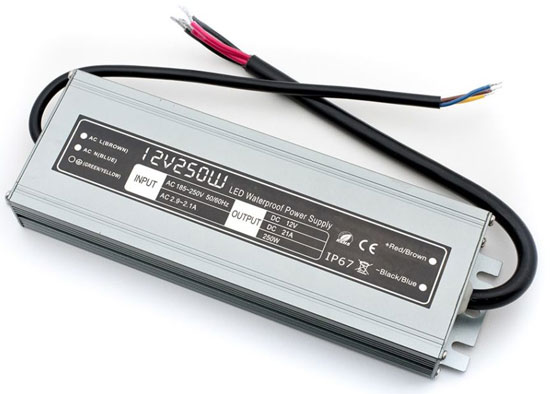
If the power of the power supply is high enough, then in devices without protection against moisture and dust, a fan will be used for cooling. During operation, it produces a certain level of noise. If the noise of the device is unacceptable for the tasks, then it is better to choose a waterproof device that will have passive cooling.
Availability of cooling
With the correct calculation of the power supply according to the power of the connected LED strips, it will not heat up and will function stably and safely. But still, if the power is too high, then overheating is possible. To exclude the negative impact of elevated temperature on the device, a cooling system is provided in its design. It can be active or passive.
With active cooling, a fan is mounted in the device case, while such power supplies cannot be made in a moisture-proof design due to the need for air circulation inside the device and exchange with the environment. Such transformers emit noise from the fan and have an increased power consumption, which are negative qualities. But it is worth noting that active cooling is the most effective way to lower the temperature of the device.
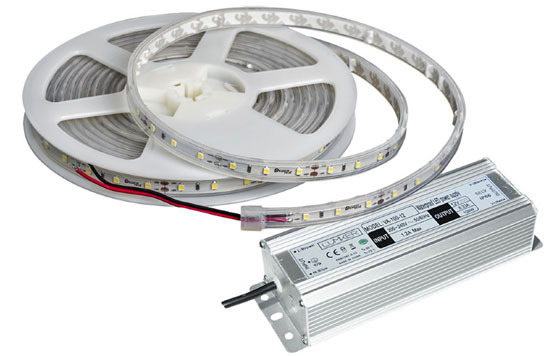
Passive cooling is structurally carried out in the form of special metal radiators, which are installed in places where the device board is heated the most. Also, passive cooling occurs due to the metal case of the devices, both in waterproof and in the usual version.
Additional functions
Power factor correction
The characteristics of power supplies sometimes indicate the presence of reactive power correction. In the documentation for the device, it is referred to as PFC or Power Factor Correction. This means that the power supply has high specifications in terms of energy saving and useful use of the consumed power. Moreover, such transformers make it possible to group them without special starters and are environmentally friendly due to their high efficiency.
Housing material
The body of the device can be made of plastic, aluminum or other metal. The aluminum case is used not only to reduce the weight of the device and protect it from damage, but also for passive cooling of the power supply. The metal housing also protects against mechanical stress and cools the device, but weighs much more than aluminum. Plastic material for the case is used for devices that will be operated with low-power LED strips and without the possibility of damage.
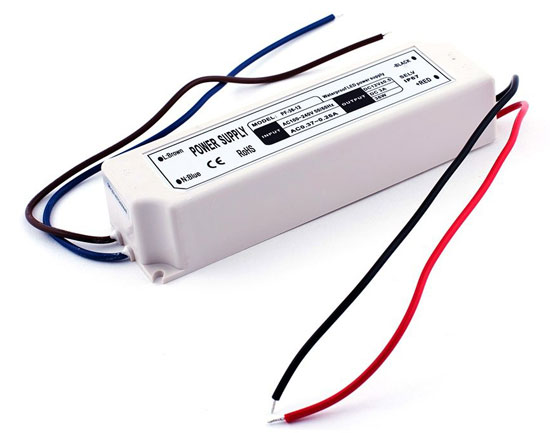
The presence of an RGB controller
To connect and use RGB and RGBW strips, it is not enough to purchase only a step-down power supply. In this case, you also need an RGB controller for the ribbon, which will allow you to change the shade of the ribbon lighting using various control devices (remote control, display, etc.).Some power supplies are equipped with such controllers and are intended exclusively for multi-color ribbons. They are more expensive than conventional transformers. For single-color LED strips, the use of a controller is not required.
Similar articles:

